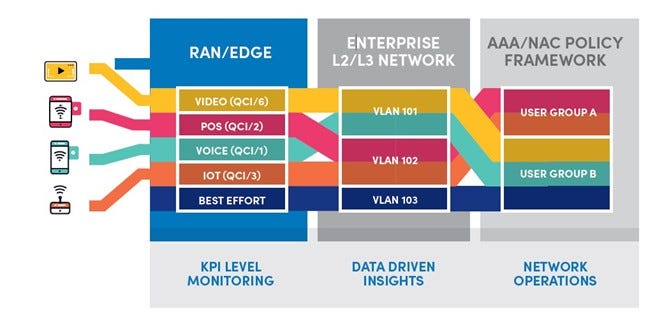Taking a Slice Out of Private Wireless NetworksTaking a Slice Out of Private Wireless Networks
Network slicing and microslicing are two new approaches to ensuring QoS over enterprise private cellular networks, but they come with some distinct differences.
April 25, 2023

Private wireless is quickly infiltrating enterprise networks everywhere. For the first time, companies now have direct access to new shared cellular spectrum, made available by the FCC and other telecom regulatory bodies around the world, to own and operate their own mobile networks.
The big move to private wireless by enterprises is being fueled by the need to solve long-standing wireless reliability problems not adequately addressed by conventional wireless technologies such as Wi-Fi. This has stalled a new era of network-dependent devices and applications on which companies rely to run their business operations.
Whether it's automating the manufacturing floor, moving materials around in the warehouse, or monitoring different parts of the production process, deterministic wireless connectivity has become non-negotiable. Without it, new Industry 4.0 applications and systems simply can't function properly, as they require ubiquitous wireless coverage, predictable connectivity, low latency, and consistent performance.
Fundamental to enterprise integration of private wireless is ensuring the highest levels of service quality for different types of devices and use cases, such as automated guided vehicles, robotics, or high-definition video monitoring. With each of these applications comes a unique set of network requirements surrounding how traffic must be handled and managed.
Two new techniques, network slicing and microslicing have emerged as the most popular approaches for defining and enforcing quality of service (QoS) over private wireless networks to improve efficiency and flexibility.
While both methods are now being used in modern private cellular network architectures aimed primarily at the enterprise, they have some key differences.
Network slicing and private wireless networks
Popularized by mobile network operators (MNOs), network slicing is a method of dividing a public cellular physical network into multiple logical networks or "slices" that can be optimized for different use cases, applications, or customers.
Using Software-Defined Networking (SDN), Network Functions Virtualization (NFV), orchestration, analytics, and automation, MNOs can create network slices that can support a specific application, service, or set of users. Network slices can span multiple network domains, including access, core, and transport, and be deployed across multiple operators.
Each slice is essentially a separate virtual network running across the larger public network that can be customized with its own network functions, bandwidth, quality of service (QoS), security, and other parameters.
It’s important to note that all devices connecting to a network slice typically share the same pre-defined QoS characteristics. While this gives organizations the ability to effectively tune the public cellular service for a unique set of devices or users, it often requires end devices to be configured with a specific APN (access point name).
An access point name (APN) on mobile devices establishes a connection to the gateway between the carrier's network and the internet. The APN finds the IP address that the device is identified with on the network, determines if a private network is needed, and chooses the correct security and QoS.
While innovative, network slicing often lacks the optimization and precision required within diverse enterprise environments that require a specific type of network performance on a per-device and application basis.
Taking the next step with microslicing
In contrast, microslicing is a novel approach designed for so-called “5G LANs” that are owned and operated by the enterprise, much like traditional wireless LANs but using 4G or 5G radio technology for user access.
Unlike network slicing, microslicing uses intelligent software embedded within the network. Microslicing automatically inspects, manages, and enforces strict QoS handling requirements for individual applications or devices as packets pass through the LAN.
Microslices use the 4G LTE QoS Class Identifier (QCI) and 5G QoS Identifier (5QI) as defined by the 3GPP standard to mark various traffic flows for unique traffic management handling.

Microslicing operation within enterprise 5G LANs.jpg
A QoS scheduler takes into account all of the pre-defined QoS requirements for a given application or device group and applies these QoS metrics on both the uplink and downlink for each cellular connection over the air.
Dedicated network edge resources, such as real-time compute, memory, and data path enforcement, are then allocated for each application or device group to create unique traffic isolation for each microslice that can be tagged or translated to the requisite VLAN or network policy that are in place within the existing enterprise network.
This allows enterprises to dynamically enforce specific latency, packet loss, and throughput requirements demanded by each use case while delivering more efficient utilization of network resources.
As a result, smaller, more granular segments or "microslices” can be created without any configuration on end devices because all the “slicing” is handled within the network.
Bottom line: Ensured QoS with network slicing and microslicing
The proliferation of private wireless networks has introduced new challenges in guaranteeing the quality of network performance as dynamic, cloud-native networks must host a diverse range of industry-specific use cases.
While network slicing and microslicing are both aimed at addressing this challenge by ensuring higher levels of service quality, they do so in very different ways over private cellular networks. Enterprises will, as always, will have the final say on which approach is best suited for their unique requirements and environments.
Related articles:
About the Author
You May Also Like




